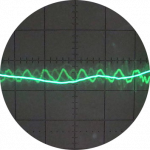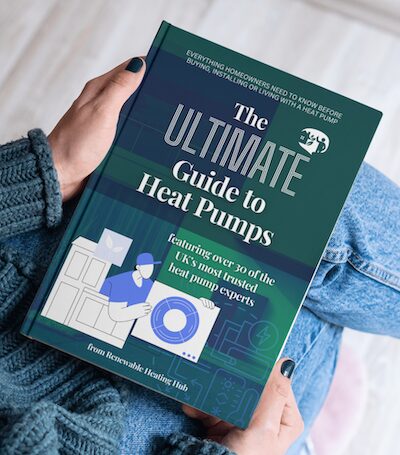No such luck yet - installers are saying their quoted 3.12 combined SCOP and the MCS minimum of 2.8 will be achieved as its winter so a poor COP of 1.9 is fine and it will balance out in the summer. They are coming back to properly balance the radiators but I don’t know if that would make that big of a difference. I’m yet to agree to sign off the install which they are chasing but it doesn’t look like they are willing to sort it out because they see no issue with the performance.
@editor I would like to add further to the installers advice:
I cant tell from the pipework in the picture but you will not get 12kW down a 28mm flow and return pipe, max we have managed as an experiment was 9kW.
The COP will be effected by using a 12kW system to generate 12 Kw but only displace 7, you must make sure that you are getting the correct flow rate on the primary lines before any of the smart controls are making anything efficient.
Do you have the original design showing you need 10-11.4kW, did they install or upgrade any emitters as part of the scheme and are there any issues with distribution, for example do all the rooms heat within normal amount of time, say an hour or sooner.
Typically hot water generation is a lower SCOP as you are using a 12kW system to generate typically 4kW to heat the water but overall this is calculated into the whole SCOP with the heating and will offset against a healthy SCOP of 3.6 or much better
AAC Group Ltd covering the Kent Area for design, supply and installation of ASHP systems, service and maintenance, diagnostics and repairs.
Professional installer. Book a one-to-one consultation for pre- and post-installation advice, troubleshooting and system optimisation.
Posted by: @ashp-bobbayou will not get 12kW down a 28mm flow and return pipe, max we have managed as an experiment was 9kW.
The COP will be effected by using a 12kW system to generate 12 Kw but only displace 7, you must make sure that you are getting the correct flow rate on the primary lines before any of the smart controls are making anything efficient.
@ashp-bobba Welcome to the forum. I would be interested to understand the reasoning behind your statements. What was your experimental set up? I would have thought that 28mm flow and return pipe would be suitable as according to the Freedom Heat Pumps calculator, the 12 kW Samsung can only produce 10.4 kW at -5 C. The predicted velocity at 30 l/min flow is around 0.93 m/s and at DT 5 this provides 10.5 kW. If flow is fixed at 26 l/min, DT would need to be around 5.77 C to provide 10.5 kW. Would this affect COP that much?
Posted by: @dinhpthe MCS minimum of 2.8 will be achieved as its winter so a poor COP of 1.9 is fine and it will balance out in the summer.
I suppose that might be true at a stretch if you were doing space heating throughout the summer, but who does that? I would dig your heels in until you get a more experienced opinion.
I will change my statement to: you cannot get 12kW or 10.4 or 9 Kw of heat down a 28mm pipe efficiently (this is not to say you wont get it down the pipe) but if you want to micro measure 2.9SCOP V 3.2SCOP V3.8SCOP then it all starts with power consumption / resistance and heat transfer (design)
The flow rate of 30l/pm (0.5l/ps) has a resistance of 407.2 Pa/m plus bends, rises and other obstacles such as valves and connections, it is better to fit 35m pipe to get the Pa/m lower on the main drag to allow a lower index circuit resistance.
The better the heat can be moved the more efficient the system to a point, SCOP is sensitive and effected by the whole system, its worth remembering also, the flow never stays the same, on commissioning you may find that for the 1st 2hrs the flow is at max across the whole system but, for example, when on DHW the main flow is naturally slightly reduced, shorter circuit, more resistance through the hot water cylinder and so on, or if secondary circuits / zones start to close down as satisfied this can have a small effect on the primary circuits.
The experiments were as follows:
Experiment 1:
Samsung 12kW on a 12m run to the 3 port valve in 28mm pipework under the floor: Issue was system tripping on no flow or low flow rate code, measured max flow rate 16l/pm (0.2666l/ps) 5.5kW max output, solution, unable to change pipework as under ground, changed primary pump to larger head and higher power = 26l/pm (0.4333 l/ps) = just over 9kW output. This was probably the best low cost fix as to dig the whole house and new UFH where the pipework was buried would have cost a fortune.
Experiment 2:
Ecodan 11.2kW on a 28mm - 6m run to the UFH manifold, max flow rate on full bypass was 0.4l/ps 8.3kw, changed cicuit to 35mm resulted in desired 0.55l/ps just over 11.2kw on a lower pump setting.
Most manufacturers recommend the following:
The flow rate from the ASHP needs to be able to match its maximum capacity so even if the Samsung will not produce more than 10.4kw at -5, it can and may during the summer or warmer weather produce more, if the heat medium is moved and the capacity available it will be very slightly more efficient. As we are measuring across a whole year (SCOP) then we want the systems to be as efficient as they can across the whole year all temperatures.
If you are watching the experts on Youtube you will see that the trend has now changed from showing how installs go in to how to make them more efficient, what should have been done better and what could have been done at install. Often as I have found over the years, they find that the flow rates are off or there is a buffer when not needed or a volumiser there when not needed or not there when needed. These items fitted or not fitted only make small changes to the efficiency overall but they are being pointed out because getting the system as near to max efficient should be important to the design.
One other example I wanted to share is that its now common knowledge amongst installers that as one of the most restrictive components on the system can be the 3 port valve, there are better 3 port valves than what come with the kits they are more expensive but have 20% less resistance to get that circuit more efficient, if the installer fits the much higher resistive pipework say 28mm on an 11kw system then it would be a waste of money charging the client for the more expensive 3 port just to reduce the circuits resistance. It's like adding 2000pa and giving it back at the cost of the client.
AAC Group Ltd covering the Kent Area for design, supply and installation of ASHP systems, service and maintenance, diagnostics and repairs.
Professional installer. Book a one-to-one consultation for pre- and post-installation advice, troubleshooting and system optimisation.
@ashp-bobba Thanks very much for your detailed reply. That is really helpful. In situations where the flow rate can deliver heat at a DT of 5 C or less,- ie where OAT is well above design temperature, would I be correct to expect my heat pump to run as efficiently as one with a higher maximum flow? In other words does the inefficiency kick in mainly when OAT approaches the design temperature and the higher flow is required to maintain DT around 5 C?
@mike-h Oh, I am not sure I can answer accurately, When I have spoken to the manufacturers in the past they have said that ensuring the correct flow rate allows the HP to distribute what it requires efficiently, the systems need to be balanced when on a fixed flow rate or commissioned at max to test when the HP can vary its flow rate and then that HP will vary the flow as it requires. I was also told in the past that the optical flow sensors are very accurate and the input from these will effect what the HP wants to do amongst multiple other sensors.
I unfortunately cant confirm exactly when a HP reaches its limits for example a 12kw only producing 10.4 and when there are stages that it may reach further than that 10.4, I was just told in some of my many training courses that it is important that these systems are matched with the flow rate required for the design and inline with each systems maximum output. Which of course is 2 different values, this is why some HP can vary the flow on the primary pump, design to max flow to prevent unwanted resistance which = wasted energy, and the HP does what it needs with the flow.
I think if you have a 9Kw heat loss design and the selected unit is a 12kW unit as the range availability is only 6kW, 8kW and 12kW then perhaps the flow rate of just above 9kW may be acceptable and perhaps the system will only ever run up to 9Kw (inverted down to say 75% by its own sensors) but there are moments when even a 9kW heat loss building will accept a 12kW load for example from a cold start the water will take everything the condensing system can throw at it assuming the water or transfer medium is exchanging fast enough, its only the fact that we have 9Kw (assuming design perfect for every room) of emitters that we need a continues 9Kw exchange until each of the areas are satisfied, the load drops off and the system inverts down until stopping / cycling.
The old heating design method was over design as much as you desire with Combi as the minimum value was always water flow rate so 28, 32, 36kW (500% over design for heating in most houses)
The new heating design method is balance everything as near to perfect, calculate everything as near to perfect and reduces losses where ever possible, pipe restrictions, type of bends, type of valves, types of fittings and calibrated a certified flow rate to match a near perfect heat generation - heat displaced.
AAC Group Ltd covering the Kent Area for design, supply and installation of ASHP systems, service and maintenance, diagnostics and repairs.
Professional installer. Book a one-to-one consultation for pre- and post-installation advice, troubleshooting and system optimisation.
@dinhp Ive just come across some info that improves your SCOP.
I was dividing your Generation kWh / Usage kWh to get COP, but it appears Samsung have the same quirk as Vaillant in in their figures in that Generation is actually Environmental Yield and doesnt include the original electrical consumption heat.
The correct formula should be (Generation+Usage)/Usage which improves things markedly. Bear in mind though that your usage figure doesnt include the energy used by the water pump.
House-2 bed partial stone bungalow, 5kW Samsung Gen 6 ASHP (Self install)
6.9 kWp of PV
5kWh DC coupled battery
Blog: https://thegreeningofrosecottage.weebly.com/
Heatpump Stats: http://heatpumpmonitor.org/system/view?id=60
Posted by: @bontwoodyThe correct formula should be (Generation+Usage)/Usage which improves things markedly. Bear in mind though that your usage figure doesnt include the energy used by the water pump.
@bontwoody That doesn't tally with my Samsung I'm afraid. For today, Samsung display's Generation/Usage = 3.05 compared to my Class 1 Electricity and Class 2 Heat meter MMSP monitoring linked to Heatpumpmonitor.org = 3.08. Samsung overestimates Electricity usage and Generation in roughly the same proportion. It also seems to estimate the electricity used by the water pump as this is displayed on ESPHome when just the water pump is running.
@mike-h I've a 12kW Gen6 Samsung and my experience is the same as yours. I don't have any MMSP monitoring but know by calculating from my own temperature sensors and displayed flow rates that the Samsung generation figure is there or thereabouts what is being transferred. I even asked the technical helpline at Joule and they confirmed COP is simply Generation/Consumption.
2 x 12kW Samsung Gen6 ASHP, 5.6kW solar PV ground mounted c/w 10kWh Puredrive battery & Solis inverter.
I’ll try and get the original post where this was stated as an excerpt was passed to me.
unfortunately I don’t find that the Samsung figures match my Open Energy Monitor figures very well.
House-2 bed partial stone bungalow, 5kW Samsung Gen 6 ASHP (Self install)
6.9 kWp of PV
5kWh DC coupled battery
Blog: https://thegreeningofrosecottage.weebly.com/
Heatpump Stats: http://heatpumpmonitor.org/system/view?id=60
So the original post comes from the Heat Pumps UK facebook site, reference to it are shown below.
The seem to think that the situation is the same as the Vaillant one
My own figures for Nov are below
My heat meter reports significantly more output than the Samsung Controller. The usage is slightly less even though I include my water pump usage in the figure. I am however using CT clamps with the emonpi to measure this.
Using the adjusted calculation for the Samsung alters its COP to 4.76. Much closer to mine.
House-2 bed partial stone bungalow, 5kW Samsung Gen 6 ASHP (Self install)
6.9 kWp of PV
5kWh DC coupled battery
Blog: https://thegreeningofrosecottage.weebly.com/
Heatpump Stats: http://heatpumpmonitor.org/system/view?id=60
- 26 Forums
- 2,364 Topics
- 53.6 K Posts
- 201 Online
- 6,029 Members
Join Us!
Worth Watching
Latest Posts
-
-
RE: Octopus Cosy Heat Pump Owners & Discussion Thread
@kevh it's worth remembering that many lsvs only actual...
By JamesPa , 4 hours ago
-

@majordennisbloodnok Education, Education, Education…
By Toodles , 6 hours ago
-

RE: Setback savings - fact or fiction?
Exactly. We only need to compare conditions, to decide ...
By cathodeRay , 10 hours ago
-
RE: Balancing financial efficiency and comfort using the Octopus Cosy tariff
I found because I have very low heat loss I can set bac...
By RadWhisperer , 13 hours ago
-
RE: Need Help Optimising My Rushed ECO4 Install: 12kW Bosch Heat Pump
Welcome @mickamills We too have an oversized 12kW Sa...
By Old_Scientist , 19 hours ago
-
RE: My Powerwall 3 Consumes 3-4 kWh/Day in Self-Consumption: Is This Normal?
@caron I can confirm that the power usage of the PW3 is...
By Old_Scientist , 19 hours ago
-
RE: Speedcomfort radiator fans
Thats true, but having tried (and succeeded) in constru...
By JamesPa , 23 hours ago
-
RE: Solis S6-EH1P8K-L-PLUS – Why I Chose It and What I’ve Learned So Far
@bash brilliant, thanks for the feedback
By energy9165 , 1 day ago
-

RE: Heat Pump Heats the House… But It’s Not Cosy. Emitter Changes or System Tweak?
@alastair There I was, feeling grumpy, he said “Cheer u...
By Toodles , 1 day ago
-
RE: Grant Aerona: Is there a setting to keep the 2-port valve open during pump blockade
Depends on OAT. Mine cycles at OAT>10 and of course...
By JamesPa , 1 day ago
-
RE: New Fogstar 15.5kWh upright solution
@transparent My conclusion is as you have noted, tha...
By Bash , 1 day ago
-
RE: Mitsubishi Ecodan R290 10kW performance
And to you too. Wishing you a very enjoyable festive s...
By Sheriff Fatman , 1 day ago
-

RE: External pipework insulation
They do? But that isn't apparent from the photos we'r...
By Transparent , 1 day ago
-

RE: Say hello and introduce yourself
@velcro welcome to the forums. Please feel free start a...
By Mars , 2 days ago
-
Daikin EDLA11D3V3 DHW Settings
I have a newly installed EDLA11D3V3 which I'm still get...
By Velcro , 2 days ago
-
RE: Midea ASHP – how to set weather compensation
@curlykatie did you get sorted with this?
By MickaMills , 2 days ago
-
RE: MyVaillant Connect Regular Disconnect
Thanks. Yes, if the time is consistently 11pm every nig...
By buckwem , 3 days ago







